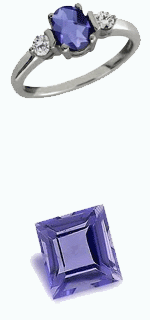| Colors: |
Gem-quality iolite can vary in color from sapphire blue to violet-like blue and from light-blue to yellowish-gray.The most desirable color is an intense violet blue that can rival that of tanzanite. |
| Shapes: |
Iolite is frequently step cut to enhance color.The most common shapes for finished stones include traditional faceted rounds, ovals and pear shapes. |
| Origin: |
Most today come from India, but other sources include Australia, Brazil, Canada, Madagascar, Burma, Namibia, Sri Lanka, Tanzania and the United States. |
| Care: |
To clean your iolite gems and jewelry, simply use warm soapy water and a soft cloth. Avoid extreme climates, temperature fluctuations and prolonged exposure to heat and sunlight. |
| Notes: |
Viking sailors allegedly used thin pieces of Iolite as the world's first polarizing filter. By looking through an Iolite lens, they could determine the exact position of the sun on cloudy days to help them navigate safely to their new worlds and back. |

